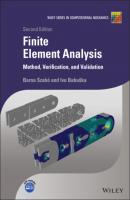Finite Element Analysis. Barna Szabó
Чтение книги онлайн.

Читать онлайн книгу Finite Element Analysis - Barna Szabó страница 22
Название: Finite Element Analysis
Автор: Barna Szabó
Издательство: John Wiley & Sons Limited
Жанр: Физика
isbn: 9781119426462
isbn:
Figure 1.3 Lagrange shape functions in one dimension,
where
1 Orthogonality. For :(1.54) This property follows directly from the orthogonality of Legendre polynomials, see eq. (D.13) in the appendix.
2 The set of shape functions of degree p is a subset of the set of shape functions of degree . Shape functions that have this property are called hierarchic shape functions.
3 These shape functions vanish at the endpoints of : for .
The first five hierarchic shape functions are shown in Fig. 1.4. Observe that all roots lie in
Exercise 1.6 Show that for the hierarchic shape functions, defined by eq. (1.53),
Figure 1.4 Legendre shape functions in one dimension,
Exercise 1.7 Show that the hierarchic shape functions defined by eq. (1.53) can be written in the form:
Hint: note that
1.3.2 Finite element spaces in one dimension
We are now in a position to provide a precise definition of finite element spaces in one dimension.
The domain
Various approaches are used for the construction of sequences of finite element mesh. We will consider four types of mesh design:
1 A mesh is uniform if all elements have the same size. On the interval the node points are located as follows:
2 A sequence of meshes () is quasiuniform if there exist positive constants C1, C2, independent of K, such that(1.56) where (resp. ) is the length of the largest (resp. smallest) element in mesh . In two and three dimensions ℓk is defined as the diameter of the kth element, meaning the diameter of the smallest circle or sphere that envelopes the element. For example, a sequence of quasiuniform meshes would be generated in one dimension if, starting from an arbitrary mesh, the elements would be successively halved.
3 A mesh is geometrically graded toward the point on the interval if the node points are located as follows:(1.57) where is called grading factor or common factor. These are called geometric meshes.
4 A mesh is a radical mesh if on the interval the node points are located by(1.58)
The question of which of these schemes is to be preferred in a particular application can be answered on the basis of a priori information concerning the regularity of the exact solution and aspects of implementation. Practical considerations that should guide the choice of the finite element mesh will be discussed in Section 1.5.2.
When the exact solution has one or more terms like